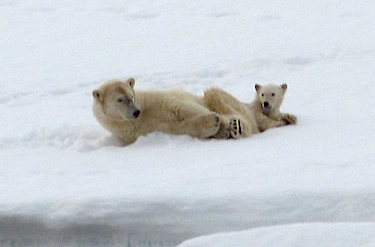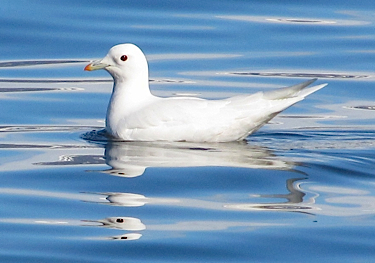For our tour description, itinerary, past triplists, dates, fees, and more, please VISIT OUR TOUR PAGE.
See this triplist in printable PDF format with media only on page 1.

Visiting the
Dovekie colony was one of the avian highlights. The sight
and sound was fabulous. (Photo by guide John Coons)
Our group enjoyed calm seas on our expedition to Svalbard where we had great encounters with so many prototypical arctic species. Polar Bear, Walrus, Arctic Fox, Ivory Gull, and Dovekie are species one has to go far north to see. And, far north we went. We reached 81º 21.026' N latitude which is 1000 miles north of the Arctic Circle and only 590 miles from the north pole. The spectacular scenery was a great backdrop for also seeing the massive bird cliffs filled with Thick-billed Murres at Alkefjellet, those colorful King Eiders swimming and standing on the ice, both Barnacle and Pink-footed geese, Red-throated Loons on the nest, breeding plumage Purple Sandpipers in flight display, Parasitic and Long-tailed jaegers, those always popular Atlantic Puffins, and numbers of Snow Bunitings singing away. We were also all dived on by Arctic Terns. Most of our landings were made on the island of Spitsbergen, but we also went ashore at Torrellneset on Nordaustlandet and the smaller island of Phippsoya. We sailed a total of 1072 nautical miles (1233 miles). Since so few species occur on Svalbard, I added the appropriate subspecific names for those that I could find information.
The great food, comfortable seas and ship, and friends we made among the quite international group of passengers and staff made for a lovely expedition to the Far North. Thanks for making it a wonderful time for me, too!
--John
KEYS FOR THIS LIST
One of the following keys may be shown in brackets for
individual species as appropriate: * = heard only, I =
introduced, E = endemic, N = nesting, a = austral migrant, b =
boreal migrant
BIRDS

A highlight for
all the passengers and staff was this Polar Bear mother
and cub staying cool on the snow. (Photo by guide John
Coons)

This Ivory Gull,
one of the great birds of the north, showed well at Ny
Ålesund. (Photo by guide John Coons)
MAMMALS

We enjoyed
several encounters with Walrus including this haul out
location at Torrellneset. (Photo by guide John Coons)
ADDITIONAL COMMENTS
Totals for the tour: 23 bird taxa and 11 mammal taxa
